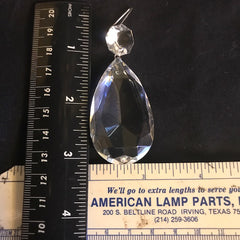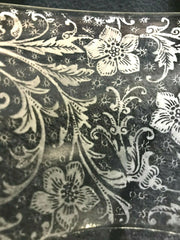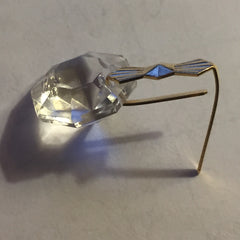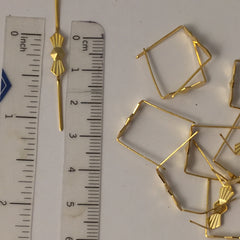Light Conversation — Restoration Files
How to Measure and Match a Crystal Piece for Replacement on Your Chandelier 0
Are you trying to measure or match your crystal pieces for replacement on your light fixture? We can help!
Measurement:
Ideally you want to get that measurement correct the first time as most folks, including us, charge restocking fees on returns of parts or they don't accept returns at all.
Replacement crystals frequently are sold with an attached octagon or button and a hook. Keep in mind that this top piece is not included in most measurements. In other words, a 2.5" almond is just that... 2.5" of almond shaped crystal with the added bonus of a top piece.
Below is a 2" measured.

We try to include the overall length (in this case 3.5"), but this height includes the pinning which can make the overall height vary a bit.
When trying to match crystals, it is more important to compare the height than the width. An off width will blend with different crystals better in most cases.
Details:
It can be quite difficult to verify that top "button" and the pinning on the piece you are wanting to purchase is the same as the piece that you need to match. If you are examining our parts, feel free to send specific questions. In most cases, we are happy to change the pinning or top piece for a small fee.
Quality:
Quality is very difficult to determine by photo. Generally, if you tell us the chandelier is pre-1980's, we can assume that the crystal are Italian quality, Czech quality, or Swarovski Strass. What does this mean?
Older Strass is unmistakable. It is thick, heavy and blindingly refractive. Newer Strass is a lighter due to the lack of lead oxide, but it is still gorgeous. (It is also thinner and etched with a trademark.)
"Italian Quality" usually means leaded crystal without great clarity. It is heavy, but whitish looking. Frequently the edges are duller and more molded looking as opposed to cut.
Czech Quality means the good, old stuff! It is a heavy, clear crystal, but not brilliantly sparkly like Strass. Sadly, this is being replaced by a newer, lighter crystal. Good for the environment (no lead) but sad for us traditionalists. Czech quality has edges that look more polished instead of molded.
Hope this is helpful.
- King's Chandelier Company
- Tags: Chandelier Parts How do I... Maintenance Restoration Files
Where does the crystal hang? 2
We are still noticing an upswing in parts related questions and chandelier cleaning related questions. I'm guessing many of you are unhappily furloughed from jobs or simply home-bound due to cancellations and are tackling some tasks around the house.
I've made a few posts about cleaning and safety which you can access from the tags to your right. I haven't addressed how to figure out where everything hangs once you have it clean.
First things first... or, maybe I should say for next time.... take a photo of the chandelier before you start removing crystal. I know we all THINK we will remember where it goes, but trust me, you probably won't.
So, let's assume you have a pile of crystal in front of you and a bare chandelier with no idea what to do.
- Separate the types of prisms/pendants. Even if some have 1 button on top and others have 2 buttons on top, sort them separately.
- Intact strands of crystal should be compared to each other and same length should be laid side to side, untangled, so you can see that they are all the same length. Place bits and pieces aside for the moment.
- Save any loose pins that may have fallen out of the crystal.
- Set aside any other loose pieces or pulled apart pieces.
Okay... so that takes care of the sorting. Now turn your attention to the frame of your chandelier. I find it easiest to sketch it out. I can't draw, so mine are laughable, but helpful.

These numbers give me quite a bit of info.
If you have strands, they will match the number of arms. If they are coming from the stem, then they will come from the 2nd bobeche where there are 8 pins, not the top where there are 12 pins. Look at where the loops are on the arm, under the bobeche. One center loop means those strands probably stretch from the front of that arm to front of the next. No loop on the arm means they probably connect to the bobeche on the arm itself.
If I have 12 of one type of crystal, they probably go on the top. 5 of a different would go on the bottom. Just start matching crystal counts to the number of pins. It is a puzzle, but you will figure it out eventually. As you start to populate the chandelier, you will be able to complete the bits and pieces.
If it is one of ours, you can send us a photo and we can guide you. If not, just web search crystal chandeliers and look at the images shown for ideas.
Some chandeliers, most particularly the metal cage framed chandeliers, are a bit more difficult to figure out. But, work on levels for your counts. Usually, each level of the chandelier will have one style of crystal.
These are not the best of times, and we wish everyone health and comfort. Keep sending your questions... our response time may be a bit slower, but we will answer.
- Nancy Daniel
- Tags: Chandelier Cleaning Tips How do I... Maintenance Restoration Files
Antique Glass Shades on the Website! 0
Summer is over, but our summer intern, Somer (you have to smile at that) has continued her project of pulling beautiful things from our treasure chests of old boxes -something we've talked about doing for, well, decades. Thanks to her hard work and meticulous photography, we have made a good start of putting these treasures on the website.
 Most of the lovelies that Somer has cataloged for us are these beautiful glass shades. Some of them date back to the 1860's we are sure, but any particular information about them has been lost over the years as we have lost the good folks that worked with them. Even if you don't need one of these shades, you will be impressed by the beauty and variety of our collection.
Most of the lovelies that Somer has cataloged for us are these beautiful glass shades. Some of them date back to the 1860's we are sure, but any particular information about them has been lost over the years as we have lost the good folks that worked with them. Even if you don't need one of these shades, you will be impressed by the beauty and variety of our collection.
As with all of our antique and vintage pieces, we've done our best to describe the condition of the particular piece, but we welcome all of your inquiries and requests for more photos.








- King's Chandelier Company
- Tags: Chandelier Parts Our Favorite Things Restoration Files
Removing the Bottom of Our Crystal Chandeliers 2
One of our most common "how do I's" is how do I remove the bottom of my crystal chandelier. We made a little video for our YouTube channel that is linked here.

- King's Chandelier Company
- Tags: Chandelier Cleaning Tips Chandelier Parts How do I... Maintenance Restoration Files
Clips and Pins for Repairing Your Chandelier Crystals 0
It has been a while since we added parts to the website, but we've updated it with a good selection of pins and clips for your re-pinning needs.
Click here to read some about the different types of pinning on our blog.
The measurements listed for the clips and hangers are the face measurement and do not include the length of the "legs" (the part that inserts into the holes of the crystals). Using the example above, the bowtie clip is measured as 13mm.
This face measurement is what will determine the distance between the two pieces of crystal that are being re-pinned. A 13mm bowtie will leave less than 13mm between the 2 pieces. Exactly how much will depend upon the size of your crystals, but there is a 9mm space using the 13mm bowtie between the two 16mm crystals in this example below.
The "leg" of the clip is the part that goes into the hole on the piece of crystal. In the photos below, you can see the difference between the "long legged" clip and the regular clip. The long legged clips are excellent for clipping into large crystals.

If you are in doubt about which type or size of clip to use, please email us. We will be happy to help you.
- King's Chandelier Company
- Tags: Chandelier Parts Maintenance Restoration Files
Putting together pieces for your crystal chandelier... 2
Have you spent hours trying to determine what you need to buy in order to put together a strand of crystals for your chandelier?
Rather than you trying to purchase all the necessary little pieces in bulk and assembling something yourself, let us do the work.

You can send us a photo of exactly what you need. This customer placed his crystal piece on a ruler, but he also gave us the dimension of each piece. We were able to duplicate his crystal strand and his chandelier looks good as new.
How to measure the pins between the crystal? Don't measure the "legs" (pieces that goes into the crystal), just simply measure the decorative part that shows between the crystals.
It can be difficult to match some things exactly - the thickness of a piece of crystal may be slightly different, or the cut may vary a tiny bit. But, we are experts! We will let you know if there are any differences and if we think it will be noticeable.
email: crystal@chandelier.com.
- King's Chandelier Company
- Tags: Chandelier Parts FAQ Maintenance Restoration Files Tools of the Trade







